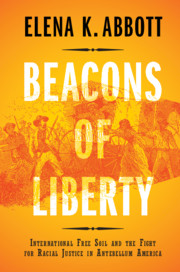Book contents
- Beacons of Liberty
- Beacons of Liberty
- Copyright page
- Contents
- List of Figures, Maps, and Tables
- Additional material
- Introduction
- Chapter 1 Reform and Relocation: West Africa and Haiti in the Early Republic
- Chapter 2 Exit and Expansion: The Search for Legal Equality in a Time of Crisis
- Chapter 3 Departure and Debate: Free Black Emigration to Canada and Mexico
- Chapter 4 Assessing Abolition: Investigating the Results of British Emancipation
- Chapter 5 Reputations and Expectations: Assessing Migrant Life in Upper Canada
- Chapter 6 Escape and Escalation: Self-Emancipation and the Geopolitics of Freedom
- Chapter 7 Free Soil, Fiction, and the Fugitive Slave Act
- Chapter 8 Emigration and Enmity: The Meaning of Free Soil in a Nation Divided
- Conclusion
- Acknowledgments
- Notes
- Bibliography
- Index
- References
- Beacons of Liberty
- Beacons of Liberty
- Copyright page
- Contents
- List of Figures, Maps, and Tables
- Additional material
- Introduction
- Chapter 1 Reform and Relocation: West Africa and Haiti in the Early Republic
- Chapter 2 Exit and Expansion: The Search for Legal Equality in a Time of Crisis
- Chapter 3 Departure and Debate: Free Black Emigration to Canada and Mexico
- Chapter 4 Assessing Abolition: Investigating the Results of British Emancipation
- Chapter 5 Reputations and Expectations: Assessing Migrant Life in Upper Canada
- Chapter 6 Escape and Escalation: Self-Emancipation and the Geopolitics of Freedom
- Chapter 7 Free Soil, Fiction, and the Fugitive Slave Act
- Chapter 8 Emigration and Enmity: The Meaning of Free Soil in a Nation Divided
- Conclusion
- Acknowledgments
- Notes
- Bibliography
- Index
- References
- Type
- Chapter
- Information
- Beacons of LibertyInternational Free Soil and the Fight for Racial Justice in Antebellum America, pp. 301 - 320Publisher: Cambridge University PressPrint publication year: 2021

